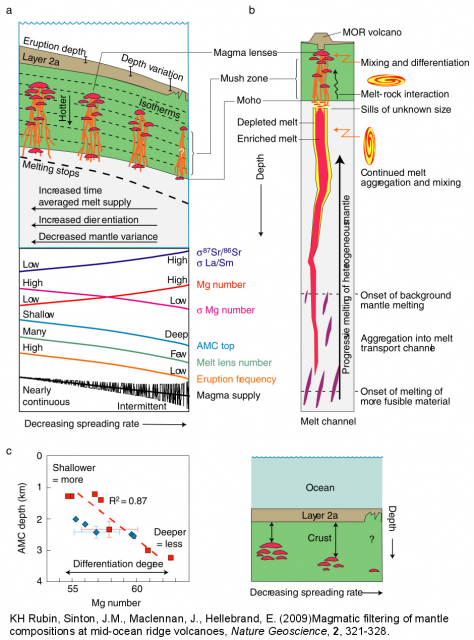Rubin
Ken Rubin, Dept. of Geology and Geophysics, University of Hawaii
We take it for granted that mantle melt is supplied to the crust to feed mid ocean ridge volcanism. Most ridge geologists will also agree that this magma supply probably varies somewhat at any given spot on the ridge. There are examples in the literature where magma supply fluctuations have been invoked to explain local variations in ridge morphology, volcanism, tectonic history, and the style and extent of hydrothermal activity in space and time along ridges. Ridge morphology and depth indicate that spatial variations in magma supply almost certainly play a role in ridge processes in the EPR and Lau Integrated Study Sites (ISSes), and temporal variations likely apply to all three ISS - but we don’t yet know by how much or at what frequency.
Three critical questions that remain to be answered relate to the causes, frequency and magnitudes of magma supply fluctuations, which feed directly into the central R2K question of what is the flux of heat and material from the mantle to the oceanic crust and the oceans themselves. Ultimately the answers will come from combined efforts of many people working at different spatial and temporal scales in many more geographical locales than the current three R2K ISSes. Some of these studies have already been conducted and their results only need to be synthesized and integrated to provide a fuller few of the overarching controls on melt supply to ridges. By putting together the multiple types of data that are ready or nearly ready to be integrated into a better understanding of the causes and effects of melt supply fluctuations at ridges, we can identify new observations, data analysis methods, and/or modeling approaches that are required for future efforts on this topic. Examples of existing observations include detailed geologic mapping of tectonic and volcanic features at sites on the EPR, JdF and MAR, among other places, and chemical analyses of associated lavas: these provide information about the sizes and durations of crustal accretion, rifting and faulting events. Compositional attributes of magmas that vary at local and global scales in response to long term, time integrated estimates of melt supply also provide clues about underlying processes. And studies of the size and distribution of crustal magma bodies, and their relationships to ridge segmentation and magma compositional variations along axis, are also key. Some of these types of observations and their implications for melt supply, which may not be widely known to the R2K community, are summarized in two recent papers that look at these issues from the crust (Rubin and Sinton, EPSL, 2007, vol. 260) and mantle (Rubin et al., Nature Geosciences, 2009, vol. 2) perspectives, respectively. Plus, the author has relatively new non-Ridge 2000 funding from NSF-OCE to study local and regional scale melt supply fluctuations on ridges in the eastern Pacific Ocean (JdF, EPR and GSC), which I can provide details of at the meeting.
Clearly, a full understanding of the causes and effects of melt supply variations on ridge volcanism and tectonism requires a multiscale and multidisciplinary approach. One of my goals for the meeting is to help bring these global and local scale observations (made both at and outside of the ISSes) to the attention of others, and to learn how they relate to other data sets, observations, and hypotheses from participants of the crust and mantle Working Groups, to address the extents of local magma supply variations at ridges, their root causes in the mantle, and their effects on crustal processes.
-----
Figure caption: Cartoon MOR cross sections summarizing the types and scales of mantle compositions, the magmatic processes that sample them, and the resulting effects on erupted MORB compositions (from Rubin et al. 2009 and references therein). The spatial scale of mantle compositions, the manner in which melts are produced, transported and pooled in the mantle, and crustal magmatic processes and thermal conditions all affect how mantle compositions are sampled by MOR magmatism. We don’t know how often these processes vary or at what length scale, or the attendant effects on MOR volcanism.

